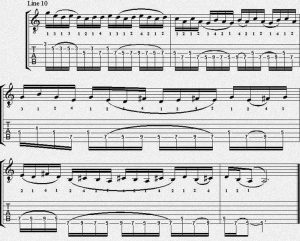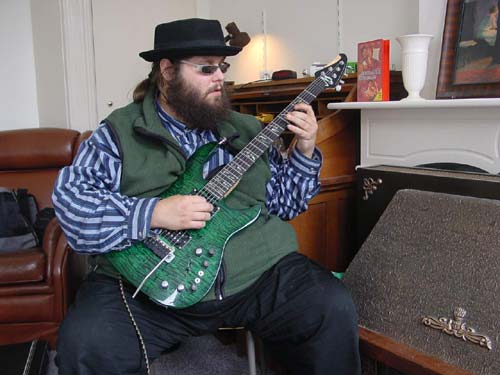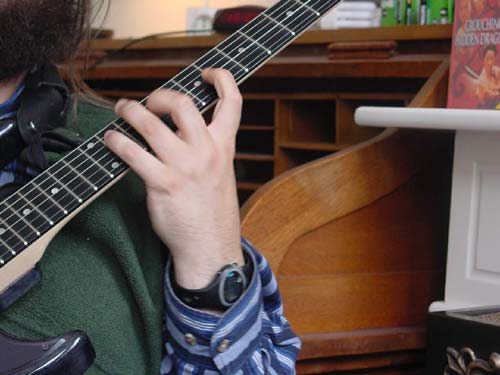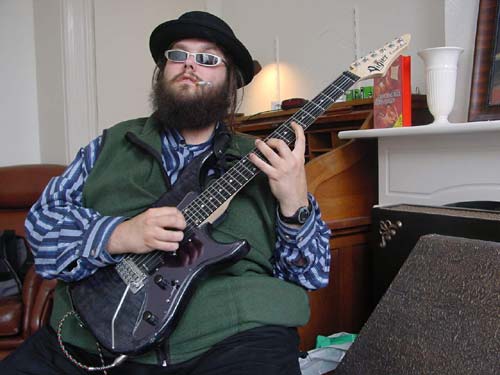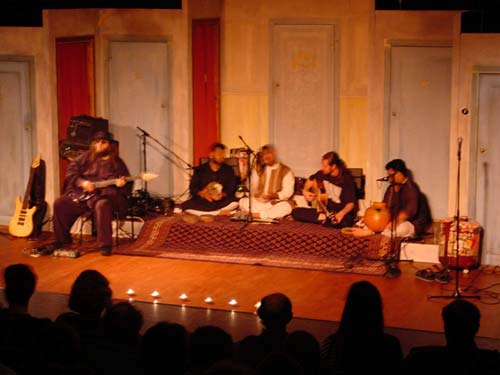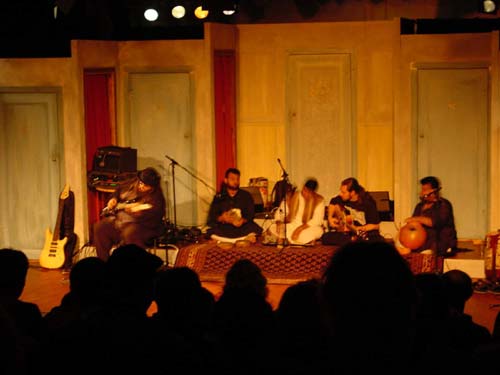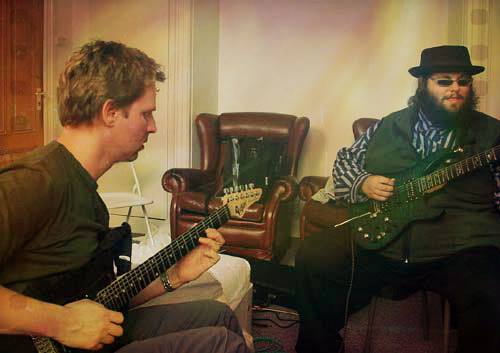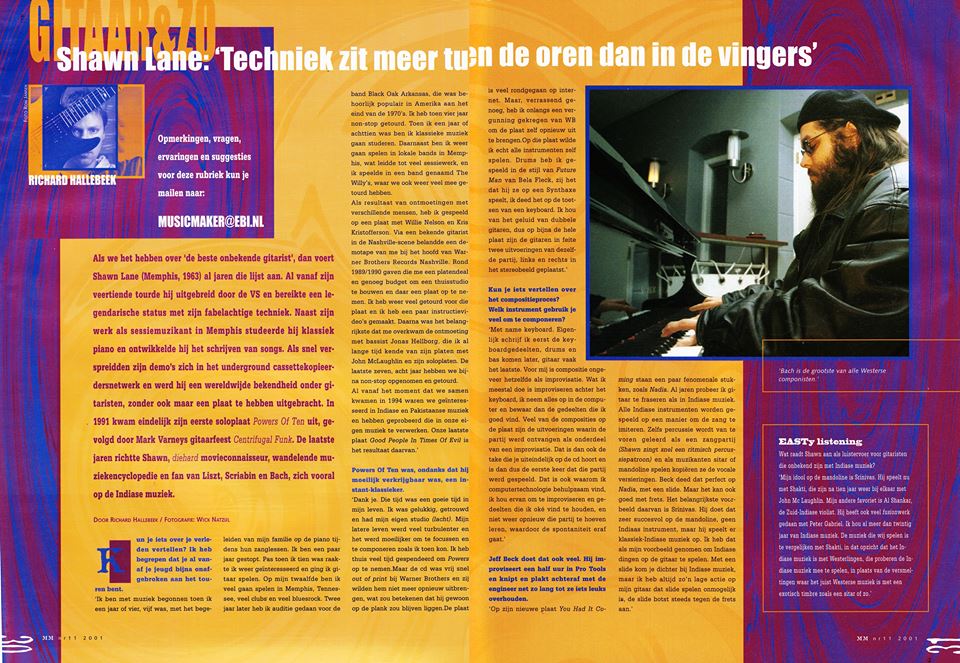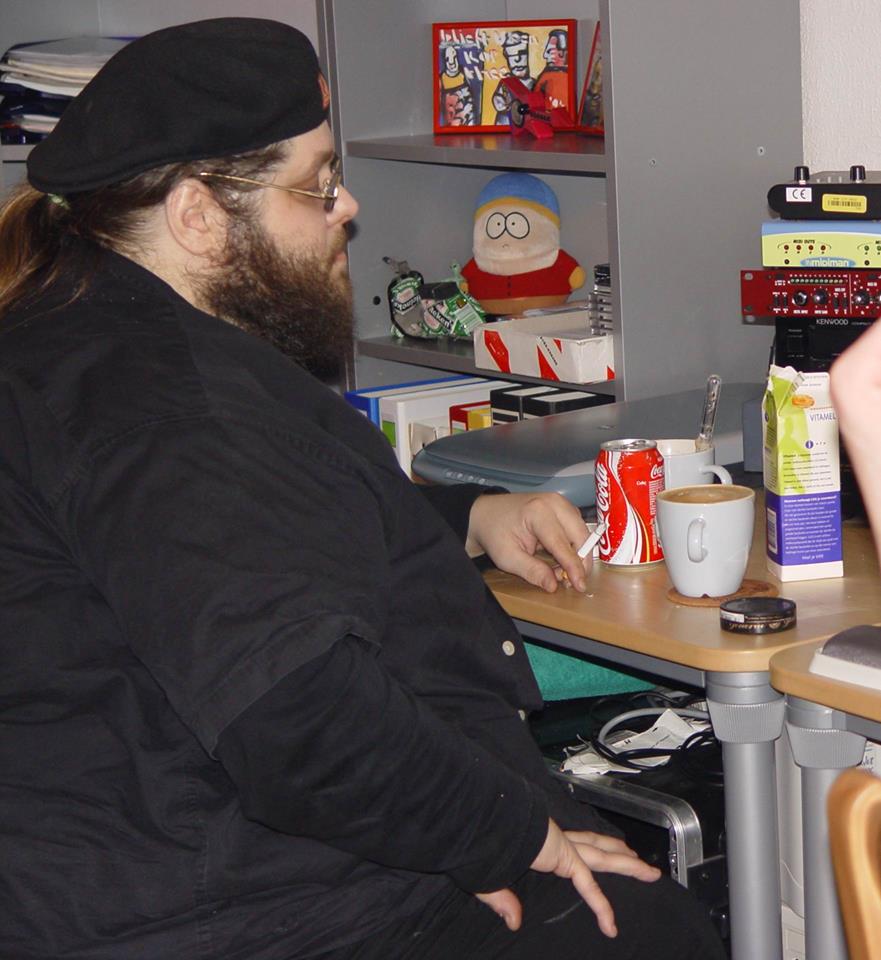Shawn was playing the Amsterdam café Berkhout march 31, 2001. I got the chance to speak to him shortly before the gig, in the Golden Tulip hotel. Due to time restraints, we had to continue our conversation after the gig, late saturday night in the café. The guitar lesson took place one month later, the 18th of June when Shawn was visiting a health center in Breukelen and staying in Holland for a few weeks. The major part of the lesson was filled discussing pentatonic ideas and sequences. All the actual soundclips are posted as they were played by Shawn. No tape manipulation going on!
This is a transcription of the full conversation. Too bad there wasn’t more time. It was a great pleasure talking to somebody who knows so much about music and art in general. [There’s some pictures included of a gig Shawn did, playing the ‘Zeeheldentheater’ in The Hague on march 18th.]
:: Maybe we can start off with a little bit off your history for the people that are unfamiliar with you?
Well, my history was, I started playing music probably about four, five years old, accompanying my older sister and mother’s vocal lessons and then I played some cello in school and took some piano lessons. Then I stopped playing music for a couple of years, I was trained a bit but wasn’t that interested in it. When I was 10 I was re interested in it and picked up the guitar and.. I did a lot better on that instrument and I guess by the time I was about 12 I started playing around a lot in Memphis, Tennessee, a lot of club gigs, playing blues and rock music. When I was 14 I auditioned for this rock band Black Oak Arkansas. That was pretty popular in America and early-mid 1970’s. I joined them at about 14 years old and toured for about 4 years non-stop, playing Black Oak music, but also as different band members left, I ended up recruiting people that were friends of mine from Memphis. So by the time I was finished playing with them, four years later, it was all my old band mates from Memphis and we were interested in kind of fusion music and were big fans of U.K. and Genesis and lots of others, besides being into Hendrix and all these other people. Even though Black Oak Arkansas was a southern rock band, by the time my friends were all in it towards the end, we had turned it into a kind of fusion band which really doesn’t esthetically work very well, Jim Dandy is more of a country rock singer, so really it wasn’t the best thing to do artistically for him (laughs) but we were just young and wanted to have fun and play and he was very understanding and let us take charge and play all this weird music for his audience..it was a weird experience. After that, I was so burned out from touring that I wanted to take some time off. So around 18 I took a few years off to study a lot of classical music and I was really tired of being on the road and stuff. I started playing around in a lot of local bands again in Memphis which led to doing a lot of session work and we had a band called the ‘Willy’s’ and we used to play around Memphis a lot and tour around the United States quite a bit. As a result of really just meeting different people I ended up playing on this album with Willie Nelson and Johnny Cash, Kris Kristofferson called ‘The Highway Man II’ album. I had a demo tape I was working on of music and I gave it to Reggie Young, who was a big session guitarist in Nashville and I just gave him my tape for him to listen to, I didn’t really tell him to shop it or try and get any opportunities. But he played it for his friend who was the head of Warner Brothers Records Nashville, named Jim Ed Norman. He, about ’89/’90 gave me a record deal with WB and supplied me with enough budget to build a home studio and record an album there. They had other acts at the time, they were trying to get more fusion acts in Nashville, it was called WB progressive division and Bela Fleck and the Flecktones recorded for them, and Marc O’ Connor and a vocal group called Take Six, they were all handled by this one little department at WB Nashville. I did some tours for that album and instructional video’s. Then, the main thing that happened to me, was about 8 years ago, I met Jonas Hellborg, who I had known about for a long time, on his records with John McLaughlin and his solo bass records. And even we had some friends in common. I’d been friends with Anders and Jens Johansson since about ’83, since I’d seen them with Yngwie Malmsteen. They came to Memphis, I met them then, after they played with Yngwie they went on and made some records with Jonas and they were always trying to get me and Jonas together. But for years, we kept missing each other. He called me and I wouldn’t be there, I’d try to call him back and miss him. We never could get together but we happened to meet in ’94 by accident at a Paris trade show and hit it off really well..and since then we just pretty much worked non-stop, the last 7-8 years.. played on many albums, tour every month or two months in Europe all over and we’ve used many different drummers in that time and we were always interested from the time we got together in ’94 in Indian music and Pakistan music and we tried to incorporate some of that in our music. In the last year or so we’ve been playing with these musicians from India and our last record called ‘Good People In Times Of Evil’ was a result of that..that pretty much brings us up to date! (laughs)
:: Pretty much yeah! Can you tell me more about the Powers Of Ten album? It’s a classic.
Well, thank you. Well, you know, it seems people like it many years later and it.. at the time it was a good time in life for me, I was happy, married and had my own studio at home. (laughs) Later years in my life became much more turbulent and it became harder to focus and write, compose like I could back then. Because in the last years I’ve been working with a lot of improvised music and stuff.. but the Powers Of Ten was the one time I really had lot of creative freedom and time to make music. I spent a long time at home making that and it came out really good. But it was out of print by WB and they weren’t gonna release it and I wasn’t able to release it which would mean it would just never be released. And there were people selling it on E-bay, on the internet auction site. But things turned around and I, surprisingly, got a license from WB to re-release the album myself. I’m about to do that. I never thought I’d be able to do that, usually greater company’s don’t do that. But they did in this case, so I’m looking forward to putting that out in the next month on my website.
:: You’ve played a lot of instruments yourself on that album.
On that album I really wanted to do one where I played everything. I did everything myself, all the engineering and mixing and I played all the instruments. The drums I played rather in the manner of Future Man with Bela Fleck. I’d seen them play a lot and instead of playing on the Synthaxe, I did it on the drums, on the keyboards. So I played the drums with my fingers, on the keyboard keys. But that album was recorded in a very tiny little room in a house, like a ten-foot little room. And the guitar amp was in the closet (laughs) On that album.. I like the sound of doubling guitars, so on a whole lot of, maybe most or all of the record practically all the guitars is actually two performances of the same lines panned from side to side. It gives it a real rich sound, I was careful to double things really close..that was another different thing about that album from some of the rest of the ones I’ve done.
:: How do you compose? Do you use mainly guitars or do you prefer keyboards?
Mostly keyboards. Actually, I usually write the keyboard parts first and put down drums and bass and usually guitar last. I always wrote more on the keyboards. But some of the songs started out as guitar songs. I think ‘Not Again’ was originally a guitar song and ‘Get You Back’ was written on the guitar.. but a lot of the other stuff was written on keyboards. For me, composing is pretty much the same as improvisation. What I would tend to do with the computer, that I used for sequencing all the instruments but the guitar, everything is all recorded in the computer. The guitar is the only thing on tape on the whole album. What I would do is improvise at the piano, sometimes with layered sounds on the keyboard. And record it all and then take parts that I like out of it. Sometimes the very first time it was ever played. Like when I was improvising and some idea just came to me and I played it. That’s the performance that is actually on the album, ’cause that’s the bit of the actual sequence that I kept. So many of the compositions the actual performance that you hear itself was the performance in which the thing was conceived as part of an improvisation. So that’s why I find computer technology useful, cause I like to improvise and then keep things that are good and not relearn them and replay them but actually just use maybe the first time it was ever played. I heard another story about that of a Pat Metheny clinic I saw 10 years ago. And he said the song ‘Are You Going With Me’ that goes: (sings main riff of the tune) that performance you hear that he had sequenced on the Synclavier is the first time it was ever played, that was recorded and that little bit is what they always used in concert in sequence and on the album and everything, so.. I think it’s kind of interesting sometimes to have that.
:: Yeah, interesting stuff. Or take Jeff Beck. He doesn’t work out too much music before he comes to the studio to record a new album. He just improvises 30 minutes into Pro Tools, they cut and past some nice riffs they like together with the engineer and work till something cool comes out and build songs around that.
I really like the last couple of Jeff Beck albums, too. The new album I’ve heard called ‘You Had It Coming’ has some stuff on it that’s phenomenal. There’s a song called ‘Nadia’ is incredible. For years now myself, I’ve been trying to phrase guitar like Indian music..and all Indian instruments, the way they are played is to mimic the vocal sound. All Indian music in based on vocals. Even the percussion parts are learned before hand as vocal parts. (sings fast rhythmic percussion part) and when people play sitar or mandolin, they’re copying the vocal ornamentation. And Beck did that perfectly on ‘Nadia’ with the slide guitar, which seems perfect for the idea because all of the slides and the ornamentation. But it can also be done with frets, the main example of that is Srinivas. He does that most successfully on the mandolin which is not an Indian instrument but he plays legitimate Indian classical music on it. I had usually taken that as my model to try to play some Indian type things on the guitar, because the mandolin is fretted and the guitar is a fretted instrument, too. I thought that by the slides that one could get closer to Indian music, and that’s true, but.. I haven’t played slide guitar very much because I always favored action so close to the neck, that you can’t play slide on it, it bumps into the frets all the time. And so I just never really played slide. But when I heard Beck’s work on the slide, that was very inspiring and he really captured the ornamentation of Indian singers with that.
:: For starters, any other players you recommend listening to as far as Indian music goes?
My idol on the mandolin is Srinivas. He plays with Shakti now, Shakti is reformed, after 10 years, with John McLaughlin and they have an album called ‘Remembered’ and another one called ‘The Believer.’ And ‘The Believer’ has the two people that I play with on it, which is Selvaganesh on kanjeera, which is an Indian tambourine and Srinivas who plays mandolin. Me and Jonas did a concert with those two. We did a concert in San Diego about three weeks ago and Srinivas was amazing on the mandolin. He’s just a phenomenon. I couldn’t recommend anything higher than Srinivas, he the best carnetic…and also my other favorite is Al Shankar, the South Indian Violinist. He’s done a lot of fusion work with Peter Gabriel and other people on the ECM label but his carnetic classical record ‘Who’s To Know’ and his other albums are phenomenal. The thing is I’ve loved Indian music for 20 years and been listening to it a lot and never dreamed I would ever get to play with Srinivas or any of these other guys. I heard all the records, loved them. When these musicians are not playing with Jonas and me, they play with Shakti as well. The music that we’re playing is similar to Shakti in that it’s basically Indian music with some Westerns trying to play the Indian music with them, instead of the types of fusions were it’s just Western music of some kind with an exotic timbre like a sitar or something like that. An obvious reference would be Shakti, because there just haven’t been that many other occasions where Westerns try to play carnetic music with real carnetic musicians.
:: Let’s move on to another classic album. The Mark Varney ‘Centrifugal Funk’ project. I’ve heard a lot of stories about that project, but like to hear some of your words about that session.
Mark Varney, yeah.. I he was a child psychologist at one time I heard.. I remember he would put sometimes disclaimers one some Legato releases, on a few of those samplers and Centrifugal Funk. Centrifugal Funk..it was a good idea to get that many players together, but he didn’t really have the budget perhaps to get everybody together so they could really jam.So the thing that maybe crippled that album for me was that it was pieced together by flying around with the tape and having different musicians play and that can be OK sometimes, but usually it’s better if the money is there, to get everybody together in the same room and have them actually play off of each other. That would have been a better idea for the record. I’m a little bit pleased with some of the things on there but the one part I hate is that solo of mine called ‘Lane’s Blitz’. It wasn’t a solo. I was arguing with Mark Varney, I didn’t wanted to do a solo by myself. He is very persuasive, and he would try to persuade me over and over. I never did it, I never agreed to do it. The tune that’s called ‘Lane’s Blitz’ was just recorded while I was warming up trying to get a guitar sound. He released it and titled it ‘Lane’s Blitz’ and I never titled it that, never put that aside as a solo. And it’s embarrassing and horrible anyway..I wish I could erase that from history, at least that solo. (laughs) But the rest of it it’s not so bad.
:: A lot of the solos were first takes right?
Pretty much everything. But that’s not that unusual for me because that’s usually what happened on ‘Powers Of Ten’ as well and almost all the albums with Jonas because almost all of those are live. That vibe in ‘Powers Of Ten’ when I was recording that, usually the first solo i’d take on something would be the best. I would keep it and record other ones on different tracks and I’d usually end up always going back to the original first track. Then I would relearn it and double it along with it. But I’ve always been a real first take kinda person. Even if they can get me before the first take, if I can be fooled into where I’m thinking it’s not even being recorded yet, that’s even better.
:: You’re guitar technique is probably the most incredible I’ve ever heard. What did you do to develop that kind of skill to such a high level? Any tips for players?
Well, I guess it’s probably more in the mind than in the fingers, so..my guess would be to try to.. maybe just to..again I would have to go back to the Indian music theme to the fact that they sing everything before they play it. They learn it in their heads first and then it’s not so hard to play on whatever instrument you’re playing it on. So instead of physically practising moving the fingers, it would probably be more of a case of getting the mind sharper to think of things a certain way. The physical practise shouldn’t take very much and I don’t practise as much as I should because I’m on the road a lot and sometimes I’ve been sick recently and haven’t had equipment at home to really practise.
:: But did you practise a lot when you were young?
I practised a whole lot when I was very young, between 10 and maybe even 18. I used to practise..just play guitar all the time. And since then, I’m always listening to new things and trying to improve estatically but I don’t practise guitar physically very much anymore. I probably could be better if I did. In the old days though, I really still didn’t practise so many scales or anything like that, I was influenced obviously by the people I have heard and I got into Art Tatum when I was a kid. About 14, 15 I started hearing some of his records and the fast sound he had when he played with his fingers on the piano, I had that early on in my head as a model of what I kind of wanted to sound, of what I wanted to hear out of the guitar. And then the other big thing was; I saw Allan Holdsworth when I was about 14 in 1978. I never dreamed a guitar could be played like that and that really changed my whole life. If I hadn’t had seen Holdsworth I may have just continued to play some blues and rock music and might have even given it up later or something, but when I saw him at 14, that really inspired me to try to play guitar in my own way at another level. That and hearing Art Tatum and Charlie Parker and all these people put these types of sounds in my head and what I play is just the result of different things I’ve heard..but I’m not that methodical about it. There is a certain number of coordinations I think that can be taught that I talk about on my instructional video. Just different mathematical coordinations then can be used just as a ready-made involuntary kind of a reflex motion. It just helps to learn. So if you have your reflexes together to basically do tuplets and triplets and quadruplets, quintuplets and so on, just the various mathematical groupings like 2’s through 8’s or whatever. And you have that together going up in pitch and going down in pitch and orient it with different numbers of notes per string, then almost any musical phrase you might need to learn, you might hear in your head you can execute because you already got the movements down as reflexes before. I think that helps maybe in improvisation sometimes. As far as why I’m attracted to fast things, I think I just, again, like the sound of some of the other people I had heard and it was somehow exiting. Later, after I found I could do some of it, it became it’s own kind of odd sensation. Sometimes it fits well in the music, but sometimes I’ve played on pop music gigs and played way to many notes and long inappropriate solos, but I just didn’t really care esthetically what it was, I was just kinda having fun in my own little world, playing. I just maybe have an unusual look on things like that, which leads ultimately to Conlon Nancarrow, who makes this music for piano that has about 200 notes per second in it a lot of times and it’s really crazy. But he was a big influence on Frank Zappa and I love Zappa records for a long time. Nancarrow had some amazing music that really turned my head around. ‘The player piano studies’.
:: Any chance you’re going to do another instructional video or book soon?
Yeah, I tried to keep my two videos that I did to a pretty basic level because I had many ideas that I wanted to save for a more esthetic video that dealt with more things about musical values and expressive values with phrasing rather than just the mathematical coordination. I hoped to do another video that explores more of the musical side of things and the things that I’ve learned that you can do with those coordinations possibly. So I do hope to do that again pretty soon. As far as getting a book together, I probably will in coordination with some of my friends. I have a friend that plays bass with me sometimes and he is a good transcriber. I don’t really read music very well. So I don’t like to put together rhythm, transcriptions or notation because I just don’t like to read any of it, so. I get other people to do that as much as possible! (laughs)’
:: Can you tell me something about the stuff you’re using at the time? Guitars, pedals, amps?You’ve switched from Ibanez to Vigier guitars a while ago?
Vigier I’ve been playing maybe 5 years. I happened to be in Paris a lot, when I was in Europe and I liked Vigier’s guitars. I think he made a really quality instrument and has a unique idea with the kind of some sort of graphite, polymer, artificial material, carbon for a stabilizer in the neck, instead of a truss rod. And the fretboard is also made of this compound. But the neck is wood, so it has a very wood feel, but you have the stability of the polymers. And also, some of the guitars that he made for me were very consistent and played very low action, real low on the guitar and real high on the guitar very consistent. I had one guitar of his, an excalibur that I used on ‘Temporay Analogues Of Paradise’ and ‘Time Is The Enemy’, almost everything. But recently he has given me another fretless guitar that I’m just starting to try to learn, that really would be good for Indian music. I’m already playing it a little bit, but it’s very hard to play in tune.
:: I’ve played that guitar a few times. It felt like a cool instrument.I had to get used to the metallic fretboard though.
But without it being metal though, it would sustain less when it’s wood, it has a more pizzicato sound and I found that by tuning it very low and for now using flatwound strings, it responds pretty well. And then I just got a new 7-string guitar from Vigier, too that I’m gonna experiment with, to put an extra high string on there. Primarely to get more into the mandolin range, because I want to do more things that sound like Srinivas, you know.
:: Steve Vai, who really made the 7 string popular, said in an interview that his original idea was to put a high B-string on there. But the string was so thin that it used to break all the time so he went for a low B. And that’s the instrument that’s gotten really popular nowadays.
I didn’t know that. It’s hard to find a string light enough that you can tune high enough. I don’t know if I’ll be able to make a high B with the 7 string I have now. I’m just now experimenting with it, but wish I could ask Lenny Breau.The only other people that I’ve heard that use 7-strings were George Van Eps who used an extra low string and Lenny Breau, he used an extra high string. But Lenny Breau is dead and I don’t know who to ask to find out what he used, how did he get the string that high? But Lenny Breau really made great use of the 7 string with the extra high string. On the albums ‘legacy’ and ‘Silence’ I think it’s called. And two live albums recorded in Toronto. Brilliant stuff. Besides that, my main tool is really Peavey pre amps, the ProFex pre amps, because I have some custom settings in there that, in the EQ department, match the EQ curve of this old amp that I grew up using called ‘Holmes Mississippi Blues Master’. I played through it for like 20 years and it’s an amp made by a guy in Mississippi that used to work for Peavey and he split on his own and made amps for a couple of years and he went out of business. I got so used to the sound of this head they made, that I couldn’t play through anything else, but it was falling apart, so I had Peavey analyze the EQ curve naturally put out by the head and make a bunch of custom patches for their Pro-Fex unit that imitated the Holmes sound actually. But I like the delays and reverbs in that and my other main tool is the JamMan of Lexicon. For years now, I’ve found that that’s really helpful in playing Indian-style music because you can put loops and if you put a loop in of a guitar just playing intervals of 1 and 5 in two or three octaves and play it backwards it sounds a lot like a tambura which is the Indian drone instrument that supplies the drone in Indian music. And also, I really like it for turning lines backwards and for.. because I’m not much of an unaccompanied guitar player I don’t play stuff a whole lot like Martin Taylor or people where it’s all the bass and rhythm and lead all at the same time. So for me the jamman is a great tool. It allows me to do things and accompany myself in ways that I normally couldn’t do. And that’s about it, I try to keep it to a minimum and tour with as little stuff as possible so usually I just take my jamman and pre amp and play through whatever amp I can rent in Europe at the time. I did have a lot of success with the Line 6 amps, I think those for the digital-era amps..when I’ve played through those they had really good sounds. I need to get a small one of those to tour Europe with so I can have the same amp every night, it would be a little bit better. I would be small enough to carry and the sound is great on the Flextone amps I think.
(Time’s up – around this time we have to leave the Golden Tulip hotel to do a soundcheck at café Berkhout. The conversation continues after a great gig of Shawn, accompanied by a DAT player, in the back of the café, in a small, but still noisy kitchen.)
:: One thing I was wondering, how’s your health? There’s many stories circulating but I’d like to hear the real deal from you.
OK. I’ve had all my life a skin condition called psoriasis, I have really bad. (shows dry rash on arms and elbows) It’s on the elbows and knees, and it’s dry and there’s no cure. I’ve had it, it’s gotten better, it’s gotten worse, but I’ve had it all my life. Sometimes I’ve had it so bad that it covered my entire body practically. It’s really painful. The only thing you can use for it is Cordizone. But I had it so much over every part of my body and I used Cordizone treatment so much I got Cordizone poison and developed what’s called ‘Cushing’s syndrome’ from too much Cordizone in the body. So I had to stop with all the Cordizone medicins and can’t do anything for it. It won’t go away it just keeps getting worse and worse. But the cortizone doesn’t work, it just temporarily works and it comes back worse even. So it’s horrible. But if that was about enough, it’s funny because Psoriasis is related to arthritis and there’s actually besides ostio arthritis which is just wear and tear for old people and rumatoid arthritis which is your own immune system attacking itself, there is another category called psoriatic arthritis where the prosiasis and arthritis are linked in some way that they don’t quite understand. And I always had psoriasis but about 3, 4 years ago I started getting arthritis really bad. That was first in my knees, where it made it hard to walk and I thought, well, obviously because I’m very heavy it makes it hard to walk and it’s harder and so it hurts more and stuff. I could see that maybe if I lost some weight then I could walk better and be OK. But then this arthritis attacked everywhere, all in my hands, my neck, my arms and every bone in my body. I couldn’t even move and I had to take lots of pain medicines to try to live.It hasn’t really got any better because there’s not really a cure for arthritis or psoriasis.All they can do is give some medications that help a little bit but it doesn’t really help a lot. And so I have to take pain medicines and I’m sick of my stomach a lot. And if I don’t take it, then I just hurt so bad that I can never even leave the bed, I’m just totally crippled, so. I’m in really bad shape. The problem is that in America, there’s no health care, national health care.And I never had the money for insurance, so I couldn’t even get health care anywhere. I could only go to the charity doctors and then get maybe some more Celebrex or Vioxx, but no real extreme treatments. Finally, after years of trying I got the state-funded health care. It took a long time and a lot of paper work and I just got that. So now I may be able to get other care, I may be able to treatments that were to expensive before. That could make the arthritis better. Until then, you know, it hurts my playing and my fingers aren’t as loose as they used to be. But if I rest a lot and I tour, and I just basically just rest and then show up and play then I’m OK. But stress and other physical functions tire me out and I can’t do anything. I can still play concerts and live with it and hopefully it’ll get better and I can have a little more stamina.
:: You have to try the hit the dead sea in Israel. People who suffer from Psoriasis come back from there and they’re completely healed. But also their skin condition returns pretty quickly when they’re back home.
I’ve heard that the salt from the sea helps and the sunshine. Then in India, there’s a fish, you can get in the water and the fish eat the sick skin off and the other ones help healing and that’s where they go if they don’t have any medicines or money. I may need to try that sometime, I don’t know.
:: Back to music. A few questions about your new album ‘The Tri-Tone Fascination’.
Wel, the ‘Tri-Tone’ is probably the next-to-newest. That embodied some material that I wrote 4-5 years back and some even older than that. I had recorded a lot of songs and I had a lot of stuff unreleased so I tried to collect it together as much that I thought esthetically could go together as possible. I put that out as the first album on my own label and own website through Memphis. But that represents actually older material that I collected to be to released for the first time. And then I’ve done three new records coming out, some are a little old, ‘Powers Of Ten’, like I said, I have the rights from WB now, so that’s coming out again. But there’s a new album called ‘Powers Of Ten Live’, which again was recorded 4,5 years ago, but I didn’t have a tape of that band in concert that sounded good enough. So I didn’t think I’d ever have one to put out officially,only some bootlegs. But somebody gave me a DAT tape that was recorded at a theater in California that sounded better then any of the other tapes I’ve had. So I just mastered and mixed and edited that. And it’s a really good performance I’m proud of, the whole band.. a great drummer named Sean Rickman that’s Phil Upchurch’s son. And then I did, since I was sick I spent a lot of time on computer and writing orchestral music because I would hurt to bad to play much guitar so I have a whole hour of album just called ‘Film Music’. Some of it was used in a few student films and a couple of short college films and then there’s stuff that hasn’t been in movies but I would like it to be so I want to use that album to shop to various directors and other people to see if I can get some of that placed in film. So the ‘Powers Of Ten Live’, the new orchestral music album and ‘Powers Of Ten’ are coming out, but I plan to do another album in the future. It’s just I haven’t had.. I had a hard time working at the studio across town.I need to rebuild a studio in my house. Because a lot of times by the time I get a ride and get set up over at the other studio Im too tired and can’t function that way. But I’ve wanted now for a few years to do an album very electronic, I really love Jeff Beck’s albums. I felt that ‘Who Else?’ and ‘You Had It Coming’ were really good. And also even parts of ‘Engines Of Creation’ by Joe Satriani. I think it’s cool to mix electronic music and techno-type music and guitar. So I’d like to do an album like that. I really love Björk a lot, I listen to her all the time I listen to a lot of techno music and computer music. I’d like to do something similar to those albums, but in my own fashion. So if I do a solo album that would probably be the next one, somewhat techno, with guitar. And that way I can go back to playing all the instruments by myself, too ’cause I can play along with the sequencer again.And just have guitar be the only taped instrument. That would fit electronic music real well. Because for one thing, there’s not a lot of musicians that live in Memphis that I like to play with very much. So when I’m there, I usually work alone. Let me add that me and Jonas are working now with a carnetic singer and were gonna try to do another album of music that’s even more Indian. You know, we’re getting a little better. We started with ‘Zenhouse’ that sounded a little Indian, but it was a little Arab sounding and then we learned more music. I think ‘Good People’ is a lot better Indian music-type album. And our new one I think we can go even further to make something very carnetic and original.
:: You were speaking about Memphis musicians. How is the Memphis music scene?
Well, I lived there all my life. I lived a few years in California, but I’ve been touring all the time since I was 14, for 25 years now. But I go home every month or every couple of weeks and I play there still on thursday nights just for fun in a friend of mine’s restaurant called ‘The Cottage’. And it’s something like this place actually (café Berkhout, small, crowded café in Amsterdam – RH) but there’s a lot of other musicians and it’s quite.. and we just play all different kinds of music, make up stuff and improvise. And that’s fun. But in Memphis..blues is very big and R&B and soul music but they never liked fusion music much there (is there actually a place where anybody ever liked fusion music? Couldn’t resist.. – RH:) I was always somewhat outcast but I did play a lot of years with blues bands and other bands. But I think there’s a lot of famous musicians and good musicians from Memphis but it’s not because it’s a very good city for music, but because it’s very hard, so people..it makes them try really hard, it makes people be good. And the audiences in Memphis are though because they’ve seen so many great people come through like Otis Redding, great people..so it’s very hard to impress them at all. So it’s hard and that’s why there’s good people.
:: What’s that guitar tone on the opening tune of ‘Tri-Tone’? It sounds like Buckethead, but then even sped up.
What that is was, I have been pretty obsessed for a little while with the music of Conlon Nancarrow, so I wanted to try to express something like that with the guitar and I wanted to do note combinations that I didn’t think could be done on the guitar. So actually what I did is constructing it by recording every note separately. So I actually just would play a note and then record however long I wanted the tone to be. If I wanted it to be longer I’d record longer, for shorter notes I just recorded for a second. And I literally just constructed it note-by-note over a couple of night’s time. Thousands of notes. I wanted to make combinations of notes that couldn’t be played, I was pretty convinced they couldn’t be. So I did that as a stand-alone loop about 8 years ago and a bootleg tape of it got in the hands of buckethead. And nobody told him that I didn’t play it, that it was assembled on tape with guitar. And so he tried to sound like that by tapping and based a lot of his style on that tape. So it’s Conlon Nancarrow influencing me influencing Buckethead. It became it’s own style. But I think it’s funny because it was because of a misunderstanding. He didn’t know that I didn’t play it so he assumed that it could just be played. Well, when I constructed it, I constructed it specifically so it could not be played. And he didn’t know that, so he achieved something going (imitates Buckethead playing fast) by tapping them in wide intervals. It’s a weird story (laughs)
:: Buckethead just joined Guns N’ Roses. I wonder if Axl let’s him play that stuff.
I can’t imagine that! I saw some reviews of the concert. They played all old songs, Guns N’ Roses songs..I didn’t see where there’s any room for him to play. I wonder if he plays the Slash solos or his own crazy solos, or what? You know, Buckethead, I thought would be great with Primus, a band like Primus is perfect for him. But Guns N’ Roses I don’t know (laughs) But I wish him well, he’s a nice guy, a very nice guy.
:: Any other plans for the close future?
Yeah, I want to do that techno album but I’m gonna release the others that are finished already first. I have little more stuff in the can finished with me and Eric Gales playing. The guitarist from Memphis that plays upside down. He lives near me and comes to my studio all the time and I hang out with him a lot. His bass player plays with me a lot. So I have some material with me and him and also the North Mississippi All Stars. Who are Jim Dickinson’s sons. Jim Dickinson is the producer that produced a lot of Ry Cooder records. He has two sons that are like 20 and 23 years old. And I’ve known them and have been playing with them for about 6-8 years. And I have a lot of stuff in the can with them, they’re doing quite well as the Mississippi All Stars. I think they played over in Amsterdam a few weeks ago.They have a record out and they run like the Conan O’Brien show in America, they’re doing pretty well there. And then one day, me and Jonas would like to play the Goldberg Variations from Bach for guitar and bass.I played a little bit of that tonight, I’m just starting to learn it and he knows more of it than me.And I think it would sound really good to have acoustic bass and acoustic, or maybe electric guitar.. and it works. Bass can play the left hand part and guitar can play the right hand part. I never really thought that it could work and it’s a very long hard work, so..We may never get to the point were we can do it, but it’s a goal. (laughs)
:: How do you study Bach if you don’t read notes to well?
All by ear. I love Bach, I listened to him for 25 years, all my life, so I never get tired of Bach. And to learn Bach and play it is such a joy, even if no one ever hears it, just to play it sitting alone at home it makes you feel good, it’s like a form of meditation. You can play it over and over and never get tired of it, it’s a miracle. Bach I think is the greatest of all western musicians. Probably most people come to that conclusion. (laughs)
Copyright Richard Hallebeek and Music Maker magazine 2001
REINVENTING THE PENTATONIC SCALE: A LESSON WITH SHAWN LANE
One of the most unique aspects of Shawn’s playing is undoubtly his unique use of the pentatonic scale and the uneven groupings of notes he uses the make the scale sound less predictable. I asked Shawn to (slowly!) share a few of his concepts during a three hour private lesson in The Hague, juni 18th 2001. Shawn was quick to point out that a lot has changed in his playing style since the release of his instructional book and video at the beginning of the 90’s. So buckle up, here we go for an update from Shawn himself!
As an appetizer, Shawn plays an E minor pentatonic sequence. Here it clearly shows his way of thinking: starting off with a group of 4 notes, the line continues with a quintuplet, sextuplet and septuplet.
If you play the rhythmic groupings the right way you can clearly hear how unpredictable the scale sounds now, also because of the wide intervallic leaps involved. Note the unconventional fingering. Shawn uses mainly three fingers of his left hand for the pentatonic scale (no pinky) something widely discussed on his instructional video.
Shawn stresses the imortancy of playing lines over three octaves. Here, he plays a B minor pentatonic example which uses pentatonic three note per string shapes, but with the middle note skipped. A very unique sound.
Another example using three note per string pentatonics. This example is in the key of B minor, but note the ‘out’ notes there (the b13 and the 9th) which give the line a very cool flavour.
Another unique aspect of Shawn’s playing style is his flawless use of powerful left hand taps to perform intervallic big leaps like 4th’s. In the next example, notes indicated with a ‘T’ are left hand taps. Note how Shawn performs those cleanly and without any major volume difference from the picked notes.

LISTEN WHOLE NECK / FAST
Next, Shawn plays an ‘E’ bassnote into his line 6 Delay Modeler, hits ‘reverse’ and plays a line over three octaves at mind-boggling speed. He points out that the line works great to get some tension going between alternating ‘E’ and ‘A’ bass notes. Note how different those same few notes sound against the different bass notes. It outlines a maj13/sus4 chord against the ‘E’ note and a Maj 7th/9 chord against the ‘A’ bass note
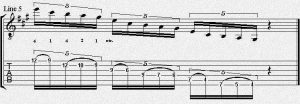
Line 5a shows the way back up which is slightly different with a repeat on the D and G string.
More left hand taps. I played on Shawn’s guitar and I can assure you his action is really extremely low, facilitated by the straight neck of his Vigier guitar. It’s possible to get an extreme light action going without string buzz on any frets and still being able to bend all strings all the way.
One of the crazy symmetrical scales Shawn uses to create tension or an ‘outside’ effect. Shawn stresses that it’s more important to use the scale at the right moment than to actually concentrate on finding the ‘right’ outside notes.
More uneven groupings, this time in E minor pentatonic for a Hendrixesque atmosphere. Watch those quintuplets.
For the advanced players: one of Shawn’s extreme stretches. It’s an Ab diminished scale

LISTEN SLOW / WHOLE NECK / FAST
Concluding, one of Shawn’s longer lines over an A minor chord. Here, there’s a lot of slurring involved and also note the use of three note per string pentatonic scales to facilitate playing those normally-hard-to-grab 4th intervals.
Try to get a feel for Shawn’s concepts by playing all the uneven groupings of notes in all the different pentatonic positions, like 3, 5, 7 or 9 notes, using different amounts of notes per string. Use as many different rhythms as you can think of, like triplets, sixteenths, etc. and also start on a different beat to get some rhythmic displacement. Make sure to be fully warmed up before attempting those wide stretches to avoid any kind of injury or tendenitis. Good luck!
 LISTEN
LISTEN 




